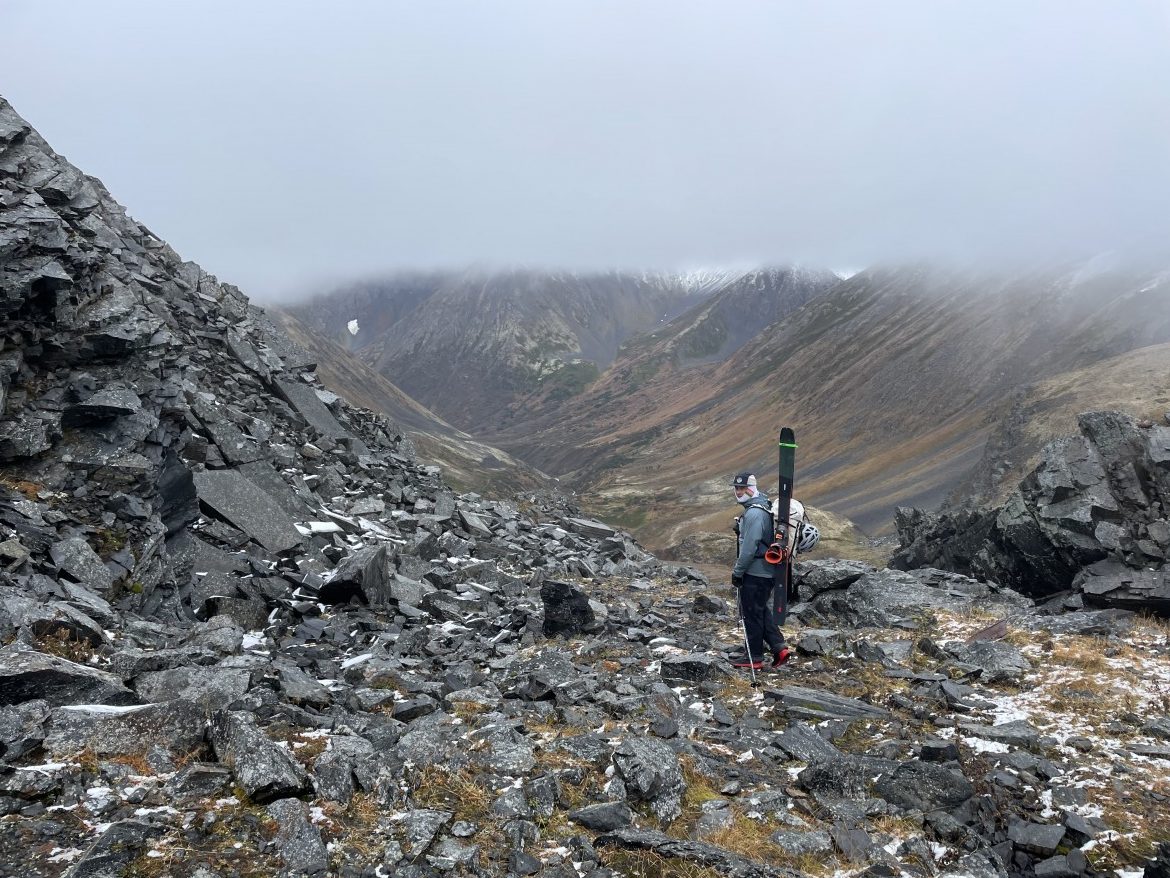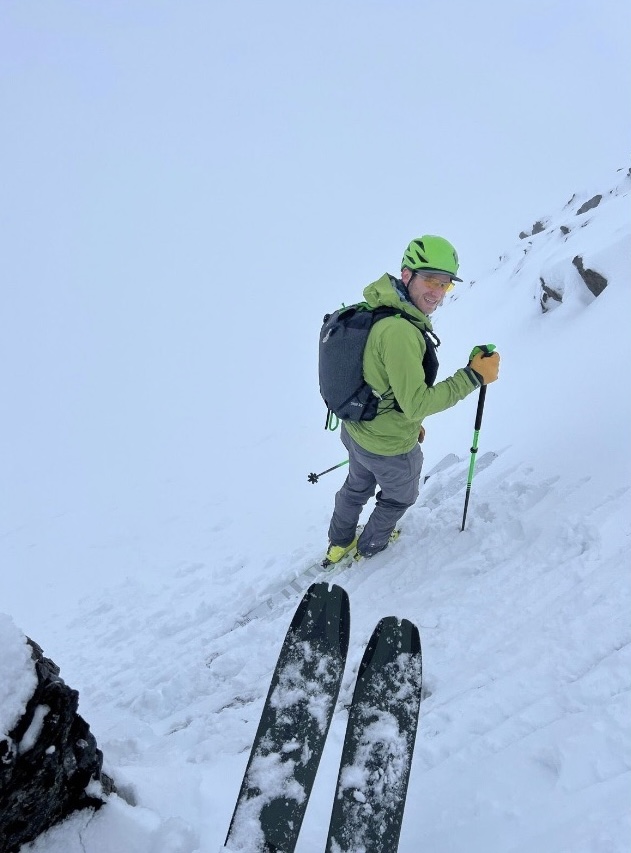
Hunting for snow in the hills of Alaska is always good training. For a former sandbagger, the hunting part has a certain appeal.
For some, training zones and training plans and documenting those efforts as they prep for backcountry skiing is tedium. Yeah, it’ll get you fit, but the good doctor up in Anchorage (Alex Lee) takes his own fitness path to be better than average. And still, some who have followed him up the skintrack, yo-yoing all day, would say he’s way-way better than average too. Here’s his advice.
Right around my 30th birthday, I remember telling my friend Joe that my knee hurt, and I had no idea why.
“Well, yea…” Joe said, with a blank stare back at me and the subtle grin of a 40-something reveling in my first venture out of youthful invincibility.
I am a semi-athlete, former sandbagger, aging millennial, part-time fanatic, uphill enthusiast, staring down the barrel of an impending decline toward dad-bod compromise. I have flat feet and I don’t like early mornings. Wise elders in the community would still call me young, but the hotdoggers out there now call me old. I am lazy at heart, but I still dream mostly about mountains. I like big days of big vert in bigger places, and I can be downright masochistic when chasing miles and mountains of bad skiing. Reconciling these identities presents a challenge.
Once upon a time, the snow would start to fly and I would just hop on skis and head uphill feeling like a well-oiled machine, even after the summer slump. But barely into my mid-thirties, I have accepted an unfortunate reality – I have to buckle down and do a bit of training if the cruel honesty of this season’s first skin track isn’t going to sting.
I know what you’re thinking, “Alex, you already switched to LIGHT beer, what more could you possibly do.”
The last few years I have picked up a small mountain running habit. I also genuinely enjoy lifting weights, but I have never really been regimented with either. My biggest challenge with taking any preseason training seriously has been the mentality of it. I am just not the guy that wears a heart rate monitor chasing Strava times. Hunting for zone 3 heart rates, tracking macros, and scheduling workouts months in advance, just isn’t my jam.
Here’s what is:
[***Disclaimer*** I am not a fitness guru, medical professional, or physiological hotshot. If you ask me about my ‘lactate threshold,’ I’ll happily tell you how much milk I put in my cereal. I’ll leave the technical breakdown to those more knowledgeable than I (check out Sam Naney’s posts). My thoughts here are mere expectations on the training mindset and what’s worked for me.]
Step One: Movement
If you are always training, then you are never training. Throw an extra bottle of water in the pack, take the long way to the top, embrace the bushwack, move uphill — it’s all training.
The next step for me has been just a bit of deliberate brass tacks:
Cardio
There is nothing quite like skinning uphill to make anyone feel like a pile of goo. I also notice that us skiers love exaggerating our cardio maintenance in the offseason. I am sorry to say it, but mountain biking is too low impact, hiking is too low tempo. And do any of us spend time in the pool? This, of course, means that we ought to go for a run. I know it’s boring and it hurts. Here’s the good news: it works. Consistent short runs that don’t push the pace build an aerobic base. One longer outing a week starts to ramp up endurance. I also really like scrambling – it’s fun, but it also helps with balance, coordination, and some of those weird small muscles that stir if forgotten too long.
When ski season comes around, I plan to ski uphill then downhill. So, in the offseason, I run uphill then downhill. Uphill pushes those hipster VO2 max stats, but personally, I have not found anything that helps get me in shape for ski season as effective as trail running downhill.
Skis make us fall in love with our corner of the mountains – for me, that’s the Front Range of the Chugach rising precipitously out of the north Pacific in Southcentral Alaska, jutting from sea-level to ice-field in less than 10 miles outside of Anchorage. Right above town sits Flattop, Peak Two, Peak Three, Peak Four, Flaketop, and Ptarmigan Peak. They guard the flanks of the Chugach, a mere 20 minute drive from downtown. My love for these places may be born of winter, but has carried over into the summer months. I might hate training, but I sure love running these peaks. They are steep enough that I gasp for air while pushing to the ridges, intricate enough that I use my hands to navigate craggy steps, and yet still runnable for long stretches of ridge and tundra, all while cruising amongst blueberries and Dall sheep.

Strength maintenance goes as planned. Pirate flag (check), full bottle + binky (check), proper deadlift form (check). Photo: Eric Dahl.
Weights
My recent COVID splurge was a squat rack in the garage.
I like picking up heavy things, and even if you don’t have access to a gym, the same principles apply (body weight exercises are great too). If you can consistently move weights twice a week, mountains will be easier. Leg strength and core strength have the most obvious benefits. I have found that keeping it simple works. I do a lot of squats, planks, deadlifts, and lunges (there are also low or no weight versions of these).
This fall, I have gotten a glimpse at some of the Uphill Athlete Free Ski Program workouts with a buddy doing the program, and if you want a regimented plan, this sort of resource seems well worth the ~$60. Tagging on to friends’ plans haphazardly has worked for me, but only so long as I hold myself to some general gym ideals–these are both silly lifting goals and a semi-structured lifting schedule.
Step Two: Motivational Advice:
If you are like me, a marmot-like indolence might keep you from being consistent, considered, or calculating in your training. To find a bit more of the motivated mindset, I have sought some advice from wiser athletes than I.
Flipping through the copy of Training for the Uphill Athlete on my shelf for inspiration, I came across a full page spread of a friend… figured I’d give her a call to start things off.
Katie Bono, no stranger to going real fast in the mountains, is an elite mountaineer, speed record holder on Denali and Rainier, former Nordic ski racer, and medical doctor. I first met Katie in a college geology class fifteen years ago while she was conspicuously watching videos of herself running during class.I’m still unsure what the idea was there, but needless to say, she takes training seriously. Luckily she told me I don’t have to get quite so fine-grained with my training plan. Katie instead offers two bits of general advice for the training mindset:
1. Make real-world, specific goals. These should be achievable, but only if you put in the work. Pie in the sky ideas can keep you dreaming on the couch, and if you pick an easy target, you’ll find yourself skipping days. Once you have a specific objective in mind, put it on the calendar.
2. Nothing sucks more than running through muddy trails in the rain alone. Find a community of folks to get out with and keep each other accountable. Or, at the very least, find other people also running muddy trails in the rain alone, so you can commiserate about it later. Normalize the training train.
Both of these are a great place to start. I feel lucky to have a community of folks I love getting out with whether on snow, dirt, rock, or water. Goals are certainly always motivating.
While contemplating my goals and community, I got a text from my friend Najeeby about going for a hike. Najeeby Quinn coaches mountain runners, eats skin tracks for breakfast, is a proud skimo speed weenie, and uber-competitive uphiller. So, I checked in with coach Quinn for some more words of wisdom.
Without missing a beat, Quinn told me, “…just sign up for a skimo race…actually, I need a winter goal, let’s do the Power of Four!” Fair enough – my legs are tired just thinking about donning spandex at the start line in February.
Coach Quinn also stresses quality over quantity. Rest on your rest days and get after it when you’re getting after it….
Skimo races are a great excuse to go on longer tours, sneak in more mid-week laps, and get ahead early in the season. Also, they are fun community events. I think some folks get scared away from the sound of skimo, but this lycra-clad community is at heart welcoming if not also inspirationally intimidating.

Looking towards Peak Two from Flattop, on the outskirts if Anchorage, during a local “training” mission.
At the end of the day, I hate training, but I love training. I am just not motivated by ‘training’, but I am by what it entails….if I don’t think of it as training. I do stuff that I find fun that also helps me get going come ski season.
So, to sum things up:
Do things you like doing for a reason you want to pursue. Go outside, pick stuff up, move your legs, and you’ll be happier later.
I caught my season opener on Sunday in the clouds above Girdwood, Alaska. A thousand feet of creamy fall snow over glacier ice, after a 3000ft rainy approach in soggy tennis shoes. With that subtle tech binding click, any and all effort in the gym or on the trail manifested in an ear-to-ear grin and a hoot….plus it was great training for next weekend.
Always.
Be.
Training.
Dr. Alex Lee lives in Anchorage, Alaska. Alex is a professor at Alaska Pacific University, teaching philosophy and environmental studies. He also works as a sometimes guide, naturalist, writer, and photographer.


